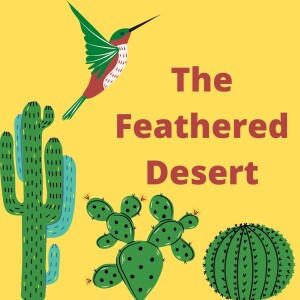
10.4K
Downloads
144
Episodes
Backyard bird feeding is one of the most enjoyable and rewarding hobbies on earth. Join Cheryl and Kiersten as they talk all about bird feeding in the desert Southwest area of the United States. They talk birds, seed, feeders, and dealing with those pesky unwanted visitors!
Episodes

Thursday Jan 19, 2023
What’s That Bird?: Yellow-breasted Chat
Thursday Jan 19, 2023
Thursday Jan 19, 2023
Summary:A three-minute podcast from the hosts of The Feathered Desert about individual bird species found in the desert Southwest.
For our hearing impaired listeners, a transcript of this podcast follows the show notes on Podbean.
Show Notes:
Bird song provided by Macaulay Library at the Cornell Lab of Ornithology recorded by Paul Marvin.
Transcript
Host voice - Welcome to the Feathered Desert’s What’s That Bird? A three-minute glimpse into the birds that we share this amazing desert landscape with.
Kiersten: The yellow-breasted chat is the only bird in the Icteriidae family and is found only in North America. As the name implies, they have a bright yellow breast and chin with a white belly and undertail. Their head, back, wings, and tail are a dark olive green. They have a white eye ring and two white stripes on the face. Males and females look similar. The juveniles will have a dusting of gray on their breast. This is a small warbler sized bird that can be found throughout North and Central America. They will be found all over Arizona in the summer time. This is a migratory bird that will spend spring and summer in NA and fly to Central and South America for winter. Occasionally some do show up in the Northeastern United States in fall and will over winter in the New England area.
Yellow-breasted Chats eat mainly insects including bees, wasps, ants, grasshoppers, and beetles. They will also eat berries and wild grapes and are often found foraging in shrubs and trees.
The best time to see a yellow-breasted chat is during breeding season at the beginning of spring. To win a mate, males will perform display flights that entail swooping down from a high perch while singing, waving their wings in an exaggerated wingbeat with their tail and legs drooping beneath. At the conclusion of the flight, they will make a thumping noise, presumably with their wings.
Males typically mate with one female per season, but some males have been known to take two mates per season. They choose new mates every year. The female remains on the nest during incubation and DNA testing has shown that quite frequently the chicks are fathered by more than just her chosen mate.
During this time of year, the males are extremely chatty, which is where they get their name, producing an eclectic song that includes croaks, whistles, and repeated phrases. (song) Listening for their call during breeding season is often the best way to find them as they are quiet and hide in foliage during the rest of the year.
Bird song provided by Macaulay Library at the Cornell Lab of Ornithology recorded by Paul Marvin.

No comments yet. Be the first to say something!